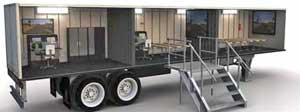| Designation: | MRAP-VVT |
 |
|---|---|---|
| Manufacturer: | Raydon Corporation | |
| Product type: | Training Simulators & Training Aids | |
| Name: | Crew training simulator |
The MRAP-VVT provides individual and collective route clearance training for: Buffalo Mine Protected Clearance Vehicle (MPCV), Husky Vehicle Mounted Mine Detection (VMMD), RG-31 and JERRV Medium Mine Protected Vehicles (MMPV), and Talon Man Transportable Robotic System (MTRS). The MRAP-VVT system can combine multiple vehicle/robot confi gurations and can be installed in an institutional classroom setting, or can be confi gured using four semi-trailer mobile classrooms. Up to 12 virtual vehicles/robots can be linked together simultaneously, which gives the ability to train up to 26 students at one time. The MRAP-VVT system can also be networked to the Virtual Combat Convoy Trainer (VCCT) and the Virtual Convoy Operations Trainer (VCOT).
Training takes place in the classroom and in virtual simulators that realistically simulate combat conditions including terrain, weather, visibility, vehicle operating conditions, IEDs, and opposing enemy forces. Warfi ghters execute exercises on a virtual battlefi eld, a geo-specifi c terrain database consisting of the Contemporary Operating Environment (COE) of Tikrit and Samarra, Iraq, and Afghanistan. Various dynamic models depict friend and foe vehicles and soldiers, IED’s and VBIED’s, traffi c obstacles, and special effects including friendly and enemy tracer rounds, explosions, smoke, vehicle dust trails and RPG smoke trails. MRAP-VVT scenarios demonstrate how to detect, mark, interrogate, and report explosive hazards in various types of terrain, road, traffi c, urban, weather conditions, and time of day. Raydon can provide training specialists who will conduct training, assist and support instructors, maintain required training records, conduct after action reviews (AAR), and perform equipment maintenance.
The Buffalo crew station consists of four vehicles, including the driver and co-driver, for a total of 8 rew positions. The Buffalo system trains warfi ghters on how to detect IEDs visually and interrogate them using the interrogation arm/crane. The Buffalo crewmembers view the virtual battlefi eld through four 40-inch LCD monitors. Features include: 180 degree fi eld of view (FOV) from an elevated seating position, camera with zoom, hand held controls for the interrogation arm/crane, and steerable spotlights for night missions.
The RG-31 crew station consists of four vehicles including driver, commander and gunner, for a total of 12 crew positions. The gunner station consists of a M2 .50 Cal machine gun mock-up with recoil and a helmet mounted display (HMD), which provides 360-degree viewing. The gunner station is unique in its ability to provide a gunner trainee realistic training for vehicle mounted weapons with unrestricted viewing of the virtual world. The commander also views the virtual environment through an HMD, which provides him with a view restricted only by the interior of the virtual vehicle in which he is mounted. This allows the unit in training to identify possible IEDs and communicate that information to the other vehicles in the route clearance team.
The Husky, JERRV (RG-33), and Talon crew stations are housed in one mobile classroom containing: two Husky crew stations, both composed of a driver position; a JERRV crew station, including driver, commander and gunner positions; a Talon IIB which includes an Operator Station, and two IOS/AAR stations. The Husky stations provide controls for identifying and marking the location of suspected IEDs. Drivers spot the suspect location, mark it with dye, and communicate the location to the other vehicles. The Talon can be deployed to interrogate IEDs, keeping warfi ghters and vehicles safe.
The IOS/AAR station provides the instructor with a means to plan and initialize, to pre-brief the soldiers prior to the conduct of training, to control the scenarios and the crew stations during training, to monitor trainee actions during scenario execution, to assess the trainee’s performance, and to review the group performance at the completion of training. The MRAP-VVT contains fi ve IOS/AAR Stations to support a combination of up to fi ve different crew courses being executed simultaneously.
|
||||||||||||||||||||
All contracts...
Related Articles |
|
Raydon awards $36 M contract for MRAP simulator (14.07.2010) |
 |
 |
